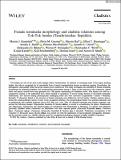Por favor, use este identificador para citar o enlazar a este item:
http://hdl.handle.net/10261/278940COMPARTIR / EXPORTAR:
 SHARE SHARE
 CORE
BASE CORE
BASE
|
|
| Visualizar otros formatos: MARC | Dublin Core | RDF | ORE | MODS | METS | DIDL | DATACITE | |

| Título: | Female terminalia morphology and cladistic relations among Tok-Tok beetles (Tenebrionidae: Sepidiini) |
Autor: | Kaminski, Marcin J.; Gearner, Olivia M.; Ras, Marcin; Hunsinger, Elliot T.; Smith, Amelia L.; Mas Peinado, Paloma; Girón, Jennifer C.; Bilska, Aleksandra G.; Strümpher, Werner P.; Wirth, Chistopher C.; Kanda, Kojun; Swichtenberg, Kali; Dariusz, Iwan; Smith, Aaron D. | Palabras clave: | Systematics Classification Ovipositor Microcomputed tomography |
Fecha de publicación: | may-2022 | Editor: | John Wiley & Sons | Citación: | Cladistics - International Journal of Willi Hennig Society 38(6): 623-648 (2022) | Resumen: | Tok-tokkies are one of the most iconic lineages within Tenebrionidae. In addition to containing some of the largest darkling beetles, this tribe is recognized for its remarkable form of sexual communication known as substrate tapping. Nevertheless, the phylogenetic relationships within the group remain poorly understood. This study investigates the usefulness of female terminalia morphology for delimiting Sepidiini and reconstructing relationships among it. Data on the structure of the ovipositors, genital tubes and spicula ventrali have been generated for >200 species representing 28 Pimeliinae tribes. This dataset was used in a comparative analysis at the subfamilial level, which resulted in recognition of several unique features of tok-tokkie terminalia. Additionally, new features linking phenotypically challenging tribes also were recovered (Cryptochilini + Idisiini + Pimeliini).Secondly, 23 characters linked to the structure of female terminalia were defined for tok-tok beetles. Cladistic analysis demonstrates the nonmonophyletic nature of most of the recognized subtribes. The morphological dataset was analysed separately and in combination with available molecular data (CAD, Wg, cox1, cox2, 28S). All obtained topologies were largely congruent, supporting the following changes: Palpomodina Kaminski & Gearner subtr.n. is erected to accommodate the genera Namibomodes and Palpomodes; Argenticrinis and Bombocnodulus are transferred from Hypomelina to Molurina; 153 species and subspecies previously classified within Psammodes are distributed over three separate genera (Mariazofia Kaminski nom.n., Piesomera stat.r., Psammodes sens.n.). Psammodes sklodowskae Kaminski & Gearner sp.n. is described. Preliminary investigation of the ovipositor of Mariazofia basuto (Koch) comb.n. was carried out with the application of microcomputed tomography, illuminating the muscular system as a reliable reference point for recognizing homologous elements in highly modified ovipositors. | URI: | http://hdl.handle.net/10261/278940 | DOI: | 10.1111/cla.12510 | ISSN: | 0748-3007 | E-ISSN: | 1096-0031 |
| Aparece en las colecciones: | (MNCN) Artículos |
Ficheros en este ítem:
| Fichero | Descripción | Tamaño | Formato | |
|---|---|---|---|---|
| Mas_Peinado_P_Female_terminalia.pdf | Artículo principal | 5 MB | Adobe PDF |  Visualizar/Abrir |
CORE Recommender
SCOPUSTM
Citations
7
checked on 01-may-2024
WEB OF SCIENCETM
Citations
8
checked on 22-feb-2024
Page view(s)
47
checked on 21-may-2024
Download(s)
51
checked on 21-may-2024
Google ScholarTM
Check
Altmetric
Altmetric
Este item está licenciado bajo una Licencia Creative Commons

